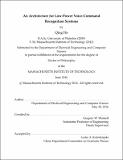| dc.contributor.advisor | Gregory W. Wornell. | en_US |
| dc.contributor.author | He, Qing, Ph. D. Massachusetts Institute of Technology | en_US |
| dc.contributor.other | Massachusetts Institute of Technology. Department of Electrical Engineering and Computer Science. | en_US |
| dc.date.accessioned | 2016-12-05T19:11:12Z | |
| dc.date.available | 2016-12-05T19:11:12Z | |
| dc.date.copyright | 2016 | en_US |
| dc.date.issued | 2016 | en_US |
| dc.identifier.uri | http://hdl.handle.net/1721.1/105574 | |
| dc.description | Thesis: Ph. D., Massachusetts Institute of Technology, Department of Electrical Engineering and Computer Science, 2016. | en_US |
| dc.description | This electronic version was submitted by the student author. The certified thesis is available in the Institute Archives and Special Collections. | en_US |
| dc.description | Cataloged from student-submitted PDF version of thesis. | en_US |
| dc.description | Includes bibliographical references (pages 149-157). | en_US |
| dc.description.abstract | The advancements in fields such as machine-learning have allowed for a growing number of applications seeking to exploit learning methods. Many such applications involve complex algorithms working over high-dimensional features and are implemented in large scale systems where power and other resources are abundant. With emerging interest in embedded applications, nano-scale systems, and mobile devices, which are power and computation constrained, there is a rising need to find simple, low-power solutions for common applications such as voice activation. This thesis develops an ultra-low-power system architecture for voice-command recognition applications. It optimizes system resources by exploiting compact representations of the signal features and extracting them with efficient analog front-ends. The front-end performs feature pre-selection such that only a subset of all available features are chosen and extracted. Two variations of front-end feature extraction design are developed, for the applications of text-dependent speaker-verification and user-independent command recognition, respectively. For speaker-verification, the features are selected with knowledge of the speaker's fundamental frequency and are adapted based on the noise spectrum. The back-end algorithm, supporting adaptive feature selection, is a weighted dynamic time warping algorithm that removes signal misalignments and mitigates speech rate variations while preserving the signal envelope. In the case of user-independent command recognition, a universal set of features are selected without using speaker-specific information. The back-end classifier is enabled by a novel multi-band deep neural network model that processes only the selected features at each decision. In experiments, the proposed systems achieve improved accuracy with noise robustness using significantly less power consumption and computation than existing systems. Components of the front- and back-ends have been implemented in hardware, and the end-to-end system power consumption is kept under a few hundred [mu]Ws. | en_US |
| dc.description.statementofresponsibility | by Qing He. | en_US |
| dc.format.extent | 157 pages | en_US |
| dc.language.iso | eng | en_US |
| dc.publisher | Massachusetts Institute of Technology | en_US |
| dc.rights | M.I.T. theses are protected by copyright. They may be viewed from this source for any purpose, but reproduction or distribution in any format is prohibited without written permission. See provided URL for inquiries about permission. | en_US |
| dc.rights.uri | http://dspace.mit.edu/handle/1721.1/7582 | en_US |
| dc.subject | Electrical Engineering and Computer Science. | en_US |
| dc.title | An architecture for low-power voice-command recognition systems | en_US |
| dc.type | Thesis | en_US |
| dc.description.degree | Ph. D. | en_US |
| dc.contributor.department | Massachusetts Institute of Technology. Department of Electrical Engineering and Computer Science | |
| dc.identifier.oclc | 964448763 | en_US |
